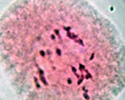
Cytogenetic characterization of a triploid mulberry (Morus spp.) cultivar Suvarna-2
Abstract
Keywords
Full Text:
PDFReferences
Anonymous. “Broucher of CSGRC, Hosur.” Published by Dr. P.K. Mishra, Director, CSGRC, Hosour.
Basavaiah and D. Shafiei. “Screening of F1 progeny for selection of superior hybrids in mulberry (Morus spp.) - A simple approach Part II: Screening of transplants in relation to seedling size.” Int. J. Bioassays, 6.2 (2017): 5260-5265. Online
Basavaiah, VM Rajan, SB Dandin, N Suryanarayana. and K Sengupta. “Chromosomal association and meiotic behavior of four triploid varieties of mulberry (Morus spp.).” Cytologia. 55 (1990): 327-333. Print
Chakraborti SP, K Vijayan, SG Doss, BN Roy and SMH Qadri. “Varietal differences on karyomorphology of some popular cultivars in mulberry (Morus spp.).” Seric., 39.1 (1999): 43-50. Print
Dandin SB, Basavaiah, MV Rajan and N Suryanarayanana. “Basic chromosome number of the genus Morus L. - A critical reappraisal.” Proc. Conf. Cytol. Genet., 2 (1989): 203-211. Print
Darlington C D. “Recent Advances in Cytology.” J. and A. Churchill, London. 1965. Print
Das BC, DN Prasad and AK Sikdar. “Colchicine induced tetraploids of mulberry.” Caryologia., 23.3 (1970): 283-293. Print
Das BC, RC Verma and AK Sikdar. “Chromosome association in natural and induced triploids of mulberry (Morus).” Cell chromosome Res., 7 (1984): 60-61. Print
Das BC and DN Prasad Evaluation of some tetraploid and triploid mulberry varieties through chemical analysis and feeding experiment. Ind. J. Seric., 13.1(1974):17-22. Print
Dwivedi NK, N Suryanarayana, AK Sikdar, BN Susheelamma and MS Jolly. “Cytomorphological studies in triploid mulberry evolved by diploidization of female gamete cells.” Cytologia, 54 (1989): 13-19. Print
Dzhafarov NA, LV Turachinova, OR Alekperova and LA Shirieva. “The new triploid variety AzN II Sh9.” Shelk., 3 (1985): 4-5. Print
Eswar Rao MS. “Improvement of mulberry through polyploid breeding.” Ph.D. Thesis, Bangalore University, Bangalore, 1996. Print
Gill BS and RC Gupta. “Cytological studies in the sex types of Morus alba L. (Moraceae).” Curr. Sci., 48.1 (1979): 35-36. Print
Gottschalk W. “Open problems in polyploidy research.” Nucleus, 21 (1978): 91–112. Print
Hamada S. “Polyploidy mulberry trees in practice.” Ind. J. Seric., 1.3 (1963): 3-4. Print
Katsumata F. “Chromosomes of Morus nigra L. from Java and hybridization affinity between this species and some mulberry species in Japan.” J. Seric. Sci., 48.5 (1979): 418-422. Print
Keshava Murthy BC, BM Prakash, H Shailaja, PP Hosagavi. “DNA marker-assisted evaluation of cultivated and local mulberry genotypes of southern India.” Crop Breed. and App., 9 (2009): 239-245. Print
Kundu D and A Sharma. “Chromosome studies in some Indian Moraceae.” In: Recent Advances in Botany, (Eds. P. Kachroo, Bishen Singh, Mahendra Pal Singh) Dehradun, pp. 348-365. Print
Ogurtsov KS. “Morphological characterestics of the pollen of some mulberry variaties in relation to ploidy.” Uzbekestan Biologya Zurnal, 2 (1979): 71-75. Print
Osawa I. “Cytological and experimental studies in Morus with special reference to triploid mutants.” Bull. Imp. Seric. Expt. Stn., 1.1 (1920): 318-366. Print
Seki H. “Cytological studies on mulberry, Morus. Part I. polyploidy of the mulberry trees, with special reference to spontaneous occurrence of triploid plants.” J. Fac. Textile and Sericulture, Shinsha Uni., Jpn, 20 (1959): 58-60.
Shafiei D and Basavaiah. “Screening of F1 progeny for selection of superior hybrids in mulberry (Morus spp.) – A simple approach Part I: Screening of seedlings in relation to seed size.” Int. J. Bioassays, 6.2 (2017): 5256-5259. Online
Sharma AK and A Sharma. “Chromosomes techniques.” Butterworth & Co., London, 1980. Print
Sinoto Y. “Chromosome studies in some dioecious plants with special reference to allosomes.” Cytologia, 1.2 (1929): 118-122. Print
Sikdar, A.K. “Qualitative and quantitative improvement of mulberry (Morus spp.) by induction of polyploidy.” Ph.D. Thesis, University of Mysore, Mysuru. (1990): 75-106. Print
Tikadar A, K Vijayan, BN Roy and T Pavan Kumar. “Studies on propagation efficiency ofmulberry (Morus spp.) at ploidy level.” Seric., 36.2 (1996): 345-349. Print
Tojyo I. “Research of polyploidy and its application in Morus.” JARQ., 18.3 (1985): 222-229. Print
Venkatesh, KH. and Munirajappa. “Cytogenetical studies in two tetraploid mulberry varieties (Moraceae).” Chromosome Botany, 8 (2013): 63-67. Print
Venkatesh KH, R Nijagunaiah and Munirajappa. “Cytogenetical studies in some triploid mulberry varieties (Moraceae).” Cytologia, 79.3(2014): 365-369. Print
Verma RC, A Sarkar and BC Das. “Cytomixis in mulberry.” Curr. Sci. 53.23(1984): 1258-1260. Print
Winkler H. “Uber die experimentelle Erzeugung von Pflanzen mit abweichenden Chromosomenzahlen.” Zeitschrift für Botanik., 8 (1916): 417–531. Online
DOI: https://doi.org/10.21746/aps.2018.7.4.14
Copyright (c) 2018 Annals of Plant Sciences

This work is licensed under a Creative Commons Attribution-NonCommercial-NoDerivatives 4.0 International License.


